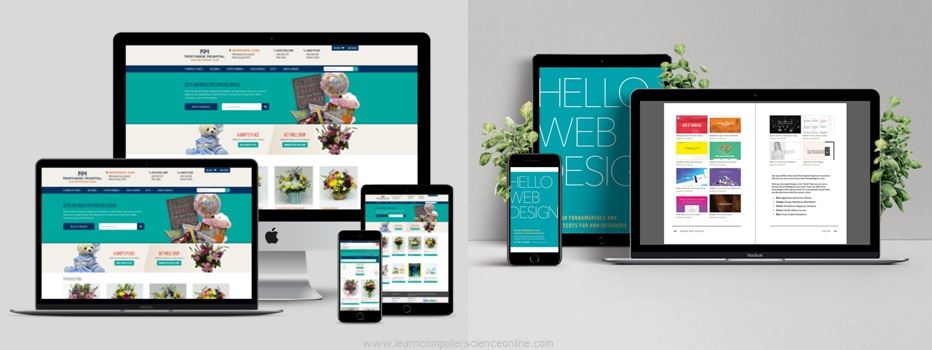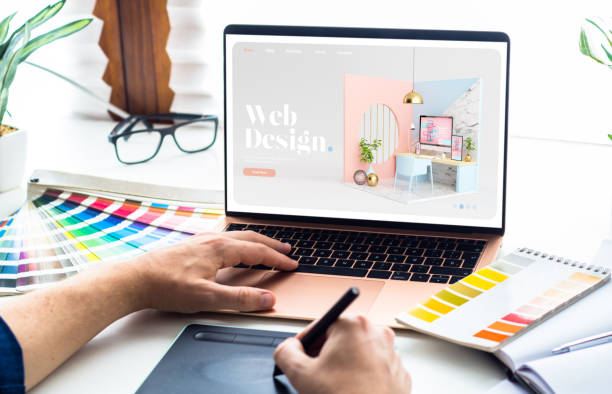Discover why visual hierarchy in website design is crucial for user experience
Wiki Article
Checking Out the Various Kinds Of Website Design and Their One-of-a-kind Advantages
The landscape of website design includes a variety of styles, each offering distinctive benefits that provide to different user requirements. Minimalist and level styles stress clearness, while responsive and material designs improve convenience across gadgets. Illustratory and typography-driven techniques intend to enhance involvement and emotional resonance. Recognizing these diverse kinds can significantly influence customer experience and brand assumption. What exists under the surface area of these layout options?Minimalist Website Design

Minimalist website design usually integrates a minimal shade palette and simple typography, which not only improves aesthetics yet also strengthens brand identification. The minimized intricacy can cause much faster filling times, further enhancing user complete satisfaction. Furthermore, by reducing visual clutter, individuals can engage with web content better, causing boosted understanding and retention. On the whole, minimalist website design promotes a smooth individual experience, making it a prominent selection for brand names aiming to share clearness and professionalism and reliability in their on the internet presence.
Responsive Web Layout
Receptive website design has actually become necessary in today's electronic landscape, making certain mobile compatibility for customers throughout various gadgets. This strategy considerably boosts individual experience by supplying smooth navigating and access, no matter display size. As more people access the Web on smart devices and tablet computers, the importance of receptive style proceeds to expand.
Mobile Compatibility Significance
As mobile device use continues to increase, making sure websites work with various display sizes has become necessary for reliable interaction and interaction. Mobile compatibility, commonly accomplished with receptive Web design, permits websites to adapt flawlessly to smart devices, tablets, and other gadgets. This versatility not only reaches a wider audience however likewise boosts brand integrity. A site that operates well on smart phones shows professionalism and trust and interest to individual needs. On top of that, online search engine focus on mobile-friendly websites in their rankings, making compatibility a vital factor for on the internet presence. By buying mobile compatibility, companies can enhance their electronic existence and deal with the growing variety of individuals who access info on the move. As a result, focusing on mobile-responsive style is important in today's electronic landscape.Improved Customer Experience

Flat Design
Level style is a minimalist strategy to Web design that emphasizes simplicity and quality. By removing three-dimensional components such as slopes, structures, and shadows, level style creates a visually appealing customer interface that prioritizes web content and capability. This style promotes an intuitive navigation experience, as users can rapidly determine crucial features and activities without interruption.Among the main benefits of level layout is its responsiveness across various gadgets and screen sizes. Its tidy lines and straightforward layouts adjust seamlessly, making sure a constant experience for individuals on mobile, tablet, or desktop computer systems. Additionally, level design frequently includes vibrant colors and typography, improving aesthetic impact and brand recognition.
The simplicity integral in flat layout leads to quicker loading times, which contributes favorably to user satisfaction. Overall, flat style remains a popular option for modern Web growth, straightening with modern aesthetic preferences while providing outstanding functionality
Product Style
Product Style stands for a style language developed by Google that focuses on producing a cohesive and user-friendly customer experience across digital platforms. This method emphasizes making use of grid-based formats, receptive computer animations, and depth results such as illumination and darkness, which aid to develop a sense of pecking order and spatial relationships. By imitating the physical globe, Product Layout allows customers to engage with digital interfaces in a much more all-natural and appealing manner.One of the essential benefits of Product Style is its flexibility across numerous devices and display sizes, making certain a regular experience for users. Additionally, it promotes a clear aesthetic language that enhances usability, making it simpler for users to navigate complex applications. The consolidation of lively shades and bold typography also plays an important duty in accentuating essential elements, consequently improving overall user involvement - website development. Product Style has come to be a popular option amongst developers looking for to create useful and visually attractive internet sites.
Typography-Driven Style
Typography-Driven Style concentrates on the strategic use of type to boost the functional and aesthetic facets of a web site. This layout technique focuses on typefaces, font sizes, spacing, and pecking order to develop visual passion and overview customer experience. By thoroughly choosing typography, developers can share brand name identity and stimulate feelings, making the web content a lot more accessible and appealing.Effective typography enhances readability and usability, guaranteeing that individuals can quickly take in and navigate the site details. The appropriate mix of kind can also establish a clear aesthetic pecking order, allowing users to rapidly identify vital messages and calls to activity.
In addition, a typography-driven technique can be adjusted to various devices, guaranteeing consistency throughout systems. This flexibility is important in today's multi-device landscape, where user experience is extremely important. Inevitably, Typography-Driven Layout offers not only as an imaginative choice yet also as a functional element that greatly influences a site's efficiency.
Illustrative Website Design
Illustrative Web style uses aesthetic narration techniques that can greatly boost user involvement. By integrating one-of-a-kind illustrations, websites can develop a memorable brand identification that reverberates with their audience. This method not only captivates site visitors but additionally communicates messages in an aesthetically engaging manner.Visual Narration Techniques
A plethora of Web developers employ aesthetic storytelling strategies to create interesting and immersive individual experiences. This strategy combines imagery, format, and typography to narrate a story that resonates with customers on a psychological degree. By integrating engaging visuals, developers can properly share messages and stimulate sensations, guiding visitors through a brand's trip. Infographics, animations, and interactive aspects offer to enhance narratives, making complex info a lot more memorable and obtainable. Furthermore, visual storytelling can develop a natural brand identification, as consistent images and themes reinforce core worths like it and messages. Ultimately, this method not just captivates users but additionally cultivates a deeper connection with the material, encouraging expedition and retention. Via skilled application, aesthetic storytelling transforms conventional Web experiences into purposeful and vibrant communications.Enhancing User Involvement
Efficient website design considerably enhances customer involvement by leveraging illustrative elements that attract interest and foster communication. Pictures can streamline complicated principles, making them extra approachable and memorable for users. They break the uniformity of text-heavy web pages, creating visual breaks that invite expedition. In addition, unique pictures can stimulate feelings, encouraging users to get in touch with the content on a deeper level. Interactive aspects, such as animations or hover results, can also improve involvement by inviting customers to participate actively as opposed to passively taking in info. This method not just maintains site visitors on the website much longer but also increases the likelihood of return sees. Inevitably, reliable illustratory website design changes the individual experience, making it more pleasurable and impactful.Branding Through Picture
Visual components play a considerable role in forming a pop over to this web-site brand's identification, and pictures are a powerful tool in site web this regard. Illustrative Web design enables brands to communicate their unique individuality and values via custom artwork. This strategy cultivates a much deeper psychological connection with the target market, improving memorability and engagement. By incorporating images, brands can differentiate themselves in a congested market, creating a distinct aesthetic story that resonates with their target market. In addition, illustrations can make and streamline complicated concepts content extra obtainable, effectively communicating messages in an engaging fashion. Generally, branding via illustration not only improves the individual experience however likewise enhances brand acknowledgment, making it a beneficial strategy for businesses aiming to establish a strong online presence.Often Asked Concerns
Exactly how Do I Pick the Right Website Design Kind for My Business?
To select the appropriate Web design kind for an organization, one should analyze goals, target audience, and market standards. Examining user experience and performance will certainly guide the choice process for perfect interaction and performance.What Equipment Are Best for Producing Different Website Design Styles?
Popular devices for developing varied website design styles include Adobe XD, Figma, Lay Out, and WordPress. Each offers one-of-a-kind features tailored to different style demands, making it possible for developers to develop functional and visually appealing sites efficiently.Just How Much Does Specialist Website Design Normally Expense?
Professional website design generally sets you back between $2,000 and $10,000, depending on intricacy, functions, and developer proficiency. Personalized solutions and recurring upkeep might boost costs, while layouts can offer even more affordable choices for easier jobs.Can I Integrate Multiple Website Design Keys In Properly?
Yes, incorporating multiple website design types can be reliable. By integrating components from numerous designs, designers can create distinct, engaging customer experiences that cater to diverse audiences while enhancing functionality and visual allure.
How Do Design Fads Influence Customer Experience and Interaction?
Design fads substantially influence customer experience and engagement by enhancing visual appeal, improving navigation, and cultivating psychological connections - branding. Remaining updated with trends allows designers to develop user-friendly interfaces that reverberate with individuals and urge extended interactionsLevel and minimal styles stress quality, while receptive and material layouts improve convenience throughout gadgets. It may seem counterintuitive, minimalist Web design highlights simplicity to enhance individual experience. Receptive Web layout plays an important duty in improving customer experience by ensuring that an internet site adjusts perfectly to various screen dimensions and tools. Level layout is a minimalist approach to Web design that emphasizes simpleness and clearness. Material Style represents a layout language created by Google that concentrates on creating a instinctive and cohesive user experience throughout digital platforms.
Report this wiki page